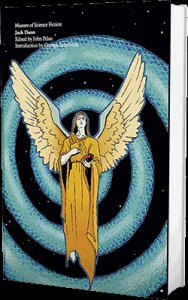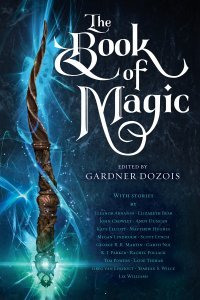Paul Di Filippo Reviews Jack Dann: Masters of Science Fiction by Jack Dann
 Jack Dann: Masters of Science Fiction, Jack Dann (Centipede Press 978-1-61347-304-7, hardcover, 752pp, $65) July 2022.
Jack Dann: Masters of Science Fiction, Jack Dann (Centipede Press 978-1-61347-304-7, hardcover, 752pp, $65) July 2022.
I think I am going to have to set up a new creditor in my bank’s automatic withdrawal system. That would be Centipede Press, who insists on issuing a steady stream of must-have volumes, all crafted to the heights of bibliophile perfection. They can just take my money automatically every month without quibble.
The latest inducement to such a spending plan is another installment in their “Masters of Science Fiction” series, this time featuring Jack Dann. I found this book to be incredibly vital in crystallizing my appreciation for—and historical assessment of—Dann’s work, a feeling which has been previously evoked sporadically, every time I encounter one of his publications. Since his first story sale in 1970, Dann has been reasonably prolific, albeit not omnipresent like some authors. And so my sense of his stature and place in the lineage of SF has been less acute than with other writers. But seeing these stories—spanning the years 1975 to 2019—assembled all at once provides an overview which firmly cements Dann’s high stature firmly into place in the genre’s canon.
With over two dozen tales on the TOC, I cannot do my usual item-by-item-summary, so perhaps we will just jump decade to decade.
“The Dybbuk Dolls” (1975) recalls the impact that Dann and other writers of his generation made in the wake of the then-mostly-extinguished New Wave. Here was a fresh pointer forward to a new kind of SF for the last quarter of the twentieth century that used the New Wave as a springboard. With its louche biopunk atmosphere (kids with multiple implanted sex organs! soul-sucking telepathic poppets!), the tale plainly prefigures Gibson and Sterling, et al, and should be cited in any histories of cyberpunk.
Right over the border into the next decade, the story “Amnesia” (1981) seems to share at least some of the continuity of “Dybbuk”, but its atmosphere is more Vermilion Sands Ballardian, right from the opening line:
It might as well have been night, even though the strong noontime sunlight turned the bistros, walk-ups, boardwalk feelies, and open-air restaurants white as bones in the desert.
Here we encounter one of Dann’s core preoccupations and themes, the separation or loss of lovers/spouses. Our hero, Mantle, searches the surreal streets of Europe for his lost Josiane, but ends up too damaged by the odyssey to claim any victory.
“Fairy Tale,” also from 1981, is our first encounter here with Dann’s mastery of a Jewish idiom and set of tropes, often humorous. Further instances (“Kaddish” and the very Blishian “Jumping the Road”) establish Dann as one of the premier interpreters of the Jewish experience in our field.
The bulk of this book hails from the Eighties and Nineties, and this was really the apex of Dann’s short fiction. He seemed willing to try anything, and to succeed every time. “Blind Shemmy” (1983) returns to proto-cyberpunk mode. “Bad Medicine” (1984) delves deeply into Native American ways. The fairground ambiance and downhome spookiness of “Tattoos” (1986) conveys Bradburyish charm and grotesqueries.
Then comes a central masterpiece, the long (eighty pages) “Da Vinci Rising” (1995), which, for the first time illustrates Dann’s deftness with fantastical historical milieus. (We would of course see this facility exfoliate further in such books as The Memory Cathedral and The Silent and The Rebel.) The portrait of Da Vinci himself is rich and authentic, but all the bit players are thickly evoked as well. Meditations on power versus art and friendship versus political loyalties shine through.
Dann’s affection for pulp narratives and pulp conventionalities shows up in “The Diamond Pit” (2001), which could be a Doc Savage adventure. “Café Culture” (2007) is a savage indictment of religious fanaticism that reminded me of the work of Norman Spinrad. And amazingly different but adjacent, “The Island of Time” (2013), a tribute to Gene Wolfe, also evokes the wistful Ellisonian vibe of “Jeffty is Five”.
Dann’s prose can be incredibly sensual and sensory-oriented. “[Leonardo] sat before a canvas he was painting, his eyes smarting from the miasmas of varnish and linseed oil and first grade turpentine.” He can also channel the numinous and the surreal, as in “Timetipping” (1975) and “Jubilee” (1995), an incredible tale of body horror and metamorphic apocalypse (again featuring a lost lover).
I stopped before the upheavals of stone and cement. I could hear them cracking and breaking, and I could hear the groaning of wood and vine as they reached upward, grasping tendrils, connecting and thickening and melding into every other leafy limb and torso. Giving birth in that connection to the silent beasts and reptiles, to the birds and insects wriggling in the soil and forming clouds in the spore infected air.
And as I stared into the rain forest, into the darkness, for it looked to me like a well, a pit, I began to make out the outlines of Ari’s cathedral, and as I stared at it, so did it seem to gain substance, and the forest began to fluoresce, as if covered with the microscopic phosphorescent organisms that set beaches and water aglow on summer nights, fluoresced into the organic flowing lines of a Gothic cathedral … into flying buttresses supporting flowering vaults — living, growing scaffolding — into naves, defined by thin boles and fronds, into spires and pinnacles, towers and gables and galleries and arches, all reaching like a hundred towers integrated into one shifting, knotted structure. Here were Reims and Sainte-Chapelle and St Maclou combined.
Several of Dann’s earliest stories appeared in anthologies curated by the legendary Robert Silverberg. If I had to pick one writer in the field to pair with Dann, it might be Silverberg himself. Both men prove themselves wide-ranging and inventive and adventurous, (occasionally through a Jewish scrim), whose humor is always leavened by gravitas and tragedy. Brothers from different mothers, and generationally distinct.
But in any case, Jack Dann’s possible cousinhood with anyone else does not impede our recognition of him as a truly unique Master of SF.
 While you are here, please take a moment to support Locus with a one-time or recurring donation. We rely on reader donations to keep the magazine and site going, and would like to keep the site paywall free, but WE NEED YOUR FINANCIAL SUPPORT to continue quality coverage of the science fiction and fantasy field.
While you are here, please take a moment to support Locus with a one-time or recurring donation. We rely on reader donations to keep the magazine and site going, and would like to keep the site paywall free, but WE NEED YOUR FINANCIAL SUPPORT to continue quality coverage of the science fiction and fantasy field.
©Locus Magazine. Copyrighted material may not be republished without permission of LSFF.







